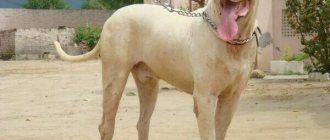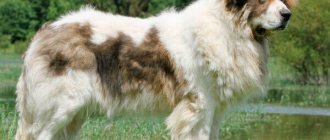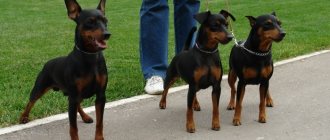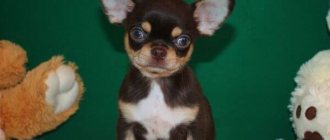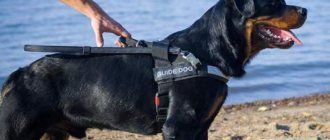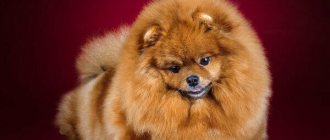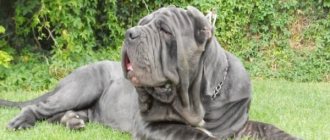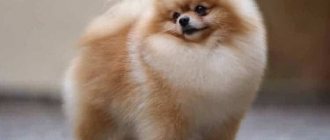Mastiffs is a name that unites a large number of breeds.
This group includes Tibetan, English, German, Spanish, Brazilian, American, Pakistani and other mastiffs.
French Mastiffs are the epitome of strength, reflected in their impressive size and fierce, serious appearance.
Such a bright, impressive exterior, coupled with an excellent watchdog and protective instinct, has determined the worldwide popularity of these dogs.
However, their special charm and mystery lies in the significant contradictions in character and appearance.
History of origin and photo of what it looks like
The French Mastiff is a dog breed bred in France, whose main purpose was hunting and protection..
These dogs are direct descendants of those known since the 14th century. Molossian dogs, which were distinguished by a strong physique, a large head, a powerful jaw and good guarding qualities.
In 1863, an international dog exhibition was held in Paris, at which all local breeds were presented, but only 1 of them conquered the judges - a Great Dane from Bordeaux named Magente.
Thanks to this red male, who took 1st place, French mastiffs were also called Dogues de Bordeaux.
Breeders devoted the next 20 years to developing the breed. There is no exact information about which breeds of blood flow in the veins of Dogues de Bordeaux. There is an assumption that during the selection they used Aquitanian Great Danes or English Mastiffs.
The French Revolution led to the death of many representatives of this breed, and the surviving individuals mixed with other species. This became the reason for the differences in the exterior, character and habits of modern representatives of the breed from those that existed previously.
This breed gained worldwide recognition and popularity after the release of the film Turner and Hooch . The first French mastiff was brought to Russia at the end of the 20th century.
Breed traits
Breed traits (on a 5-point scale)
| Dogue de Bordeaux (French Mastiff) | |||
| Activity | in the house | 3.5 | |
| on the street | 4 | ||
| Obedience | training | 3.2 | |
| strangers | 1 | ||
| Domination | in family | 2 | |
| over dogs | 3.8 | ||
| Defending your territory | from people | 4.4 | |
| from dogs | 4.6 | ||
| Sociability | in family | 3 | |
| with strangers | 1 | ||
| with dogs | 3.1 | ||
| Concentration | in family | 3 | |
| in front of strangers | 3.1 | ||
| with dogs | 3.4 | ||
| Aggressiveness | in family | 1.5 | |
| to strangers | 5 | ||
| to the dogs | 4.8 | ||
| to cats | 3.5 | ||
| Family behavior | calmness | 3.5 | |
| demand for affection | 2 | ||
| excitability | 2.6 | ||
| playfulness | 2.1 | ||
| excessive barking | 2 | ||
| behavioral breakdowns | 2.8 | ||
| Tolerance for children | up to 4 years | 2.5 | |
| over 4 years old | 2.2 | ||
| Institutional use | watchman | 4.2 | |
| bodyguard | 4.6 | ||
This breed is often compared to the following dog breeds: Bullmastiff, Cane Corso, Mastino Neapolitano (Neapolitan Mastiff), Rottweiler, English Mastiff.
The photo shows what Dogues de Bordeaux look like:
Description and standard
Dogue de Bordeaux is an athletic dog with a well-built, muscular, squat body. They have a rather menacing appearance, inspiring fear in those around them who are not familiar with this breed.
Breed standard:
- the head is large, wide, angular, trapezoidal in shape;
- the muzzle is wide, not too long, with symmetrical folds of skin above the eyebrows, near the lips, on the cheeks and above the nose;
- the jaws are powerful and strong, the bite is undershot;
- the nose is wide, upturned, flat, the nose is brown, black or reddish in color;
- eyes are almond-shaped, set wide, color varies from black to hazel;
- the ears are triangular in shape, small, set high;
- limbs are straight, strong, muscular, set parallel.
The coat is thin, short and soft . The guard hair is a maximum of 2 cm long, the undercoat is short and not dense. Shedding is moderate.
Appearance of the Dogue de Bordeaux
Nature has generously rewarded the Dogue de Bordeaux with an athletic build, good health and remarkable strength. Despite some squatness, the Bordeaux look harmonious, and the extravagant charm of the animals smoothes out their external roughness.
The standard provides for a certain height and weight of Dogues de Bordeaux. The height of males at the withers reaches 60-68 cm, their body weight is 50 kg and above. Bitches have other parameters: height is about 58-66 cm and weight is in the range of 45-50 kg. Sexual dimorphism is pronounced. Males are massive and heavy, and their character is more restless.
Head and skull
Sit down, let's go!
When viewing the dog from above, the trapezoidal shape of the head is noticeable; when looking at the animal from the front, it is square. The convex forehead is divided by a shallow hollow in the center. Folds radiate from it, which deepen when the Dogue de Bordeaux is excited. The brow ridges and cheekbones of the dog give noticeable volume to the skull.
Muzzle
The Bordeaux muzzle is slightly shorter than the forehead. Its distinctive feature is a “mask” that is a tone darker than the main color of the coat. The stop is sharply defined, almost a right angle. The wide lobe is upturned, but not flattened. The lips are fleshy and form an inverted “tick”. The chin is massive.
Ears
The small ears of the Dogue de Bordeaux are rounded, their tips barely reaching the outer edge of the eyes. Their high and wide (compared to each other) fit visually makes the dog’s skull more massive. The ears rise when the animal is excited and fit tightly to the cheekbones if the dog is alert.
Eyes
Set quite low. The color of the iris can be different: hazel or brown in dogs with a dark “mask” on the face, light brown in animals with a red “mask”. The last option is also typical for dogs with a complete absence of a “mask”.
Jaws and teeth
The Dogue de Bordeaux's lower jaw protrudes forward and rises slightly above the upper. The dog's incisors are set on the same line. Representatives of the breed are characterized by an underbite (bulldog bite).
Neck
The Dogue de Bordeaux's neck is cylindrical. The scruff is convex, connected to the wide withers of the animal. The appearance of the dewlap and dewlap is created by the folds of skin on the dog's throat.
Dogue de Bordeaux muzzle
Frame
Dogue de Bordeaux, rear view
The body of the “Bordeaux” is elongated and has a massive bone structure. The withers are elevated. The shoulder blades are pressed tightly. The back turns into a rather convex loin, and that into the sloping croup of the Great Dane. The chest is well filled. The rounded ribs are slightly flattened on both sides. The lower part of the chest meets the taut hemline.
Tail
It has a wide base and moderate length. Its tip is lowered to the animal's hock joints. When at rest, the tail hangs down, and when moving, it rises 100°.
Forelegs
They are distinguished by their particular massiveness in the shoulder area, which form a right angle with the shoulder blades. Elbows are pressed. The forearms and pasterns are vertical. The paws are strong, “equipped” with crowded toes and strong claws. The pads are elastic.
Hind limbs
Placed at a smaller distance from each other in comparison with the forelimbs. Developed muscles are noticeable on the wide hips of the dog. The joints are emphasized, the metatarsals are steep. The paws are slightly longer than the front ones, and there are no dewclaws. The claws are strong.
Movement style
Dogues de Bordeaux prefer to trot, but as speed increases, they begin to “creep” along the ground. The leisurely pace of the dog is characterized by ambling. In other cases, the movements are sweeping and elastic.
Dogue de Bordeaux in motion
Coat
The Dogue de Bordeaux's coat is short and thin, quite soft, and fits tightly to the dog's body. There is no undercoat.
Color
The breed standard allows for dark and light shades of brown. White points on the chest and fingertips are acceptable. The “mask” is a tone darker, may be black or absent. The latter case is characterized by a reddish or pink color of the nose.
Possible defects
Dogue de Bordeaux at a dog show
Any (even the slightest) deviation from the Dogue de Bordeaux standard is considered a breed defect. The most common:
- close bulldog, scissor or level bite;
- swaying of the croup in a vertical plane when moving;
- weak and rather stretched back and/or lower back;
- sharply tucked or straight abdominal line;
- undefined muscles of the limbs;
- close-set and/or round eyes;
- timidity and melancholy;
- heavy movements;
- loose physique;
- undeveloped jaws;
- hyperexcitability;
- elongated neck;
- small teeth.
Disqualifying faults of the Dogue de Bordeaux include:
- hunchbacked/sagging back and/or lower back;
- domed or bulldog-shaped head;
- barrel-shaped or flat chest;
- white points on the dog's head and body;
- aggressive or cowardly behavior;
- square or elongated body;
- large or small eye shape;
- atypical pigmentation of the iris;
- low or high neck position;
- excessive thinness or obesity;
- snoring when the animal moves;
- shortened upper lip;
- “femininity” of males;
- very short tail;
- undescended testicles;
- straight fangs.
Pet character
The appearance of Dogues de Bordeaux is deceiving. It seems as if these are angry and aggressive animals, but they are not. These dogs have a calm, balanced and friendly character and a stable psyche.
French Mastiffs become attached to all family members, but they choose one person as their owner and remain devoted to him until the end of their days..
They need the attention and care of their owner, they strive to spend as much free time with him as possible and cannot stand loneliness. Attention deficit negatively affects the psyche and behavior of the pet.
Despite the pronounced instinct of a protector and guard and a wary attitude towards strangers, representatives of this breed are not prone to causeless aggression - they need a good reason to attack.
Dogues de Bordeaux are wonderful companions and excellent nannies . They are ready to accompany their owner everywhere and always, and they have a special love for children and treat them very kindly.
These dogs will always protect children and play with them with pleasure, patiently enduring all pranks . Representatives of this breed do not have problems with other pets, especially if they grew up together.
These dogs are intelligent and quick-witted and are easy to train as they quickly learn new commands.
It is forbidden to shout at your pet or physically punish him - he will stop trusting the owner and will harbor a grudge.
Expert opinion
Kozhevin Semyon Kirillovich
Expert dog handler.
It is not typical for Dogues de Bordeaux to show aggression unless there are direct reasons for it. To protect the territory, their own appearance is enough for them - it is unlikely that strangers will risk messing with such a dog. However, these are still serious animals and they need proper upbringing and early socialization, without this they can grow uncontrollable and can be dangerous. It is important that the owner of the Great Dane is a strong person with leadership qualities and a strong character.
Owner reviews
Real reviews from French Mastiff owners without embellishment:
Emilia . The Dogue de Bordeaux character is just right for the laziest owners: I can do everything, but I don’t want to. It's so wonderful to sleep with him! It just takes up a lot of space.
Catherine . I love dogs very much, but I really don’t like getting up in the morning. And the dog would have to be walked early in the morning. For a long time I didn’t know what to do. Then one day I was at a dog show and saw a handsome red guy. I approached the owner to ask about the dog purely out of curiosity. When she said that the dog is lazy and likes to sleep a lot, I realized: this is my breed! Yes, the puppy is very expensive, but I wasn’t looking for a show version. It was important for me to have another “sloth” at home. My God, what a cute pleated little bun this is! And most importantly: Blitz does not disturb the neighbors below in any way, because he is so quiet. True, we had to give him a separate room to make him feel comfortable.
Andrey. The Dogue de Bordeaux is a great dog! Lives in my yard. There is no additional need for walking. Playful, but in moderation. Very kind and affectionate. He loves to give my children rides on his broad back. Blossom is somewhat clumsy. Several times, while playing with our cat Grace, I stepped on her tail. The most important thing is that this is the only type of injury caused by Grace Blossom. Can you imagine the size of a cat and a Great Dane? I thought he would crush her in a moment! But no, Grace is alive and well. But Blossom got it from her: she gave him a good whack in the face by the tail.
Mikhail . My wife and I decided to get ourselves a Bordeaux. We found a good nursery, bought a puppy and brought it home. What happiness this is! A playful, gentle dog, but not a shy one. Behind the demon's skin is an angel. His wife named him Belyashik. Now he is 3 years old. A huge handsome man with cute folds on his face. Even though he weighs 1.5 times more than my wife, I can be calm when she walks with him. I know for sure: Belyash will not escape anywhere and will not harm her. As a matter of fact, walking with SUCH a dog, it’s unlikely that anyone would even dare to approach my missus.
Anastasia . Lucy is our favorite redhead slobbery face. Her character is simply super! We often leave our children with her, fearing absolutely nothing. Lucy is great at keeping kids occupied. He can even help rock our youngest son in his crib in the evenings. And most importantly, she doesn’t bark at them at all! But she has 2 drawbacks: she is very slobbery and she is allergic to beef. But it’s okay, we got used to them and adapted. The main thing is that our ward loves us as much as we love her.
Advantages and disadvantages
In addition to excellent watchdog and security qualities, beauty and grace, Dogues de Bordeaux have the following advantages:
- endurance;
- devotion;
- absence of causeless aggression;
- sociability;
- ability to get along with other pets and children;
- intelligence and intelligence;
- learning ability;
- courage;
- friendly character and stable psyche.
Like other breeds, these dogs have some disadvantages.:
- tendency to obesity;
- stubbornness;
- touchiness;
- need for constant attention;
- intolerance of loneliness;
- snore.
A significant drawback for many is the high price of puppies of this breed.
Dossier
Adult height: male 60-69 cm, female 58-65 cm. Weight: 46-50 kg. Characteristic color: yellowish-brown with reddish and isabella shades; good pigmentation is important. Coat length: very short. Life expectancy: 8-12 years. Advantages of the breed: high level of intelligence, courage, devotion. Difficulties of the breed: aggressiveness, isolation, touchiness. Average price of a French Mastiff: puppies $450, adult dog $900. Classification: large breed; molosser/guard dog.
Is it suitable for living in an apartment? On the street?
Apartment keeping is not the best option when it comes to Dogues de Bordeaux . These are large dogs that need a lot of space.
The best option for representatives of this breed is locally in a private house with a garden plot, where they can move without problems during the warm season.
These dogs have short hair, so they are sensitive to low temperatures - they should not be kept outside in winter..
Training
The characteristics of the breed make it necessary to train the Dogue de Bordeaux from the moment of its purchase. As soon as the puppy gets used to the owner, training should begin. The main condition for the success of training these dogs is the absence of shouting and displays of cruelty. These methods cause the dog to be afraid of its owner and lose trust in him. French mastiffs have an excellent memory; it will not be possible to re-educate or retrain an adult animal later.
At first, the puppy, separated from its mother, is fearful and sad. You need to win him over and pick him up more often. The puppy should receive affection from the owner and members of his family; he must not feel lonely. You should not be afraid that excessive care will affect the dog’s watchdog qualities. He will remain an excellent watchman and reliable friend in any case. During training, the dog should feel calm and goodwill emanating from the owner. According to experts, it is enough for representatives of this breed to be able to recognize their own and strangers, prevent the appearance of strangers, and not take food from someone else’s hands.
During training, you cannot deliberately instill cruelty in her. This can lead to an outburst of aggression and injury to the person.
How to properly care
Caring for French Mastiffs is not difficult. It is necessary to regularly carry out hygiene procedures, as well as provide the pet with the necessary physical activity.
Wool and bathing
These dogs have a short coat and moderate shedding, so there is no need for regular thorough brushing.
It is enough to walk through the fur 1-2 times a week with a special rubber glove to remove lost hairs and dead skin particles..
After each walk, you need to wash your pet’s paws and wipe them with vegetable oil. The dog should be bathed completely as it gets dirty, about once every few months.
It is necessary to treat and wash skin folds daily, especially on the face - dust and dirt accumulate in them, which leads to inflammation and skin diseases.
Eyes
The eyes of Dogue de Bordeaux are prone to souring, so they need to be inspected daily and wiped with a cotton pad dipped in warm boiled water and tea leaves.
Ears
The ears should not be dirty or give off an unpleasant odor . They should be examined every few days and if redness, inflammation, large amounts of sulfur, or other symptoms of infection are detected, contact a veterinarian.
Teeth
Several times a week you need to brush your pet's teeth using a special brush and toothpaste . If tartar has formed, you should contact your veterinarian for a cleaning.
Claws
If the claws do not grind down on their own during walks, they need to be trimmed with a guillotine nail clipper 1-2 times a month, and the sharp edges should be filed down.
Walk
French Mastiffs do not like active games and heavy physical activity, but they still need daily walks.
You should walk your pet 2 times a day, providing him with moderate physical activity - this helps to avoid obesity.
You need to wear a muzzle when taking your dog outside.
Life expectancy and major diseases
Dogues de Bordeaux are strong and hardy dogs with good health, but they cannot be called long-livers. On average, representatives of this breed live 8-10 years.
These dogs also have a tendency to certain diseases, including:
- ear infections;
- lymphoma;
- gastric volvulus;
- kidney pathologies;
- arthritis;
- allergic reactions;
- epilepsy;
- diseases of the heart and blood vessels;
- flatulence;
- hip dysplasia;
- cancer;
- hyperkeratosis.
Also, Dogues de Bordeaux are susceptible to infectious diseases such as enteritis, plague, leptospirosis, salmonellosis, parainfluenza, etc., and bitches often experience complications during childbirth, since puppies have large heads.
CAREFULLY!
In addition, French mastiffs cannot tolerate heat and if they stay in a closed and stuffy room for a long time, they experience shortness of breath and problems with the cardiovascular system, which can be fatal.
The development of many diseases occurs due to the fault of dog owners . Therefore, it is necessary to provide the pet with proper care and proper living conditions, regularly visit the veterinarian for routine examinations and carry out vaccinations according to the schedule.
Nicknames
After you have adopted a dog, the question arises of what to name it. The table shows some options for nicknames for boys and girls.
| For boys | For girls |
| Alex | Alba |
| Bodysuit | Sultana |
| Vasco | Jesse |
| Graph | Elsa |
| Jack | Jasmine |
| Magent | Kitty |
| Zack | Lucky |
| Leo | Matilda |
| Buffalo | Olivia |
| Nelson | Polly |
How to feed?
The diet of these dogs can be based on natural products or industrial food; the main thing is to monitor the balance of the diet and avoid mixing the two types of feeding.
When eating natural foods, you should include in your diet:
- lean meat;
- sea fish;
- vegetables, fruits, herbs;
- dairy products;
- offal;
- eggs.
Dogues de Bordeaux do not need cereals, but if the owner wishes, porridge made from buckwheat, rice or oatmeal can be included in the diet.
Can't be given to a dog:
- chocolate and other sweets;
- smoked meats, pickles;
- tubular bones;
- milk and sour cream;
- millet, wheat, barley porridge;
- spicy and fried foods;
- river fish.
It is also forbidden to feed your pet food from a common table - this can cause problems with the gastrointestinal tract.
Industrial food has a balanced composition and is enriched with vitamins and minerals; you just need to choose the right food for your pet, taking into account its age, health and activity.
Preference should be given to premium, super premium and holistic food products..
The brands Orijen, Acana, Evo, Royal Canin have a good reputation.
The number of feedings depends on the age of the dog:
- 2 months – 6 times;
- 3-4 months – 5 times;
- 5-6 months – 4 times;
- 8-12 months – 3 times;
- 1 year and older – 2 times.
The daily food intake should be 20% of the dog’s body weight.
Nutrition
Let's start with the main thing - Dogues de Bordeaux eat a lot. They are large, so they need a decent portion of carbohydrates and proteins. Since such a dog moves little, it can easily become fat. Therefore, we recommend feeding her 2, or preferably 3 times a day. For 1 meal she needs to eat from 500 to 600 grams of food. This can be natural food or industrial feed.
Few people give such huge dogs natural food on a regular basis, because this is problematic. Therefore, most owners opt for a ready-made diet for their pets. A Dogue de Bordeaux puppy should gain more than 10 kg in the first months of life. Therefore, in addition to dry food, his menu must include:
- Cottage cheese.
- Low-fat soup.
- Boiled meat and fish.
- Vegetables and fruits.
- Berries.
You can also additionally give him boiled eggs, pasta, borscht and offal (liver, heart, lungs, etc.). This food is rich in protein and microelements that a young dog’s body needs. After he reaches 7-8 months, all this food can be eliminated from his diet. Give him dry food rich in vitamins every day. Don't skimp on it!
How to choose a puppy?
Before buying a puppy, you should get to know its parents, find out about their health and character. You also need to inspect the living conditions of the dogs and ask the breeder about the nuances of feeding.
IMPORTANT!
The puppy must be active, socialized according to age, show curiosity and have a good appetite.
He should not be overweight or underweight, have no rashes, irritations, dandruff, bloating or other visual signs of pathologies. This should be a puppy with strong bones, shiny coat, and an underbite.
Character largely depends on the gender of the dog: males are more willful and stubborn, it is more difficult to force them to obey, and females are more cunning, but more flexible.
Nurseries in Russia
Dogue de Bordeaux is a fairly popular breed, so there are many nurseries specializing in their breeding.:
- Star Shaine, Yekaterinburg;
- Winner Show, Moscow;
- "Madrid Courtyard", Moscow;
- Valents House, Moscow;
- Maximovs, Moscow region;
- Empire Of Demons, Moscow;
- “Giant Pets”, St. Petersburg;
- Dorsdorf, Moscow.
Purchasing a puppy from a kennel guarantees that it is a purebred and healthy representative of the breed.
Price range
The cost depends on the class of the puppy. So, a representative of the pet class will cost 30-35 thousand rubles, a breed class - 50-60 thousand rubles, for a show class puppy you will need to pay 75-85 thousand rubles .
According to the advertisement, you can buy a puppy for 8-12 thousand rubles, but in this case there is no guarantee that it is not a mixed breed or that the puppy does not have developmental pathologies.
How much does a Dogue de Bordeaux cost?
The price of a Dogue de Bordeaux depends on several factors.
Among the main ones is the class of the dog; location of the breeder; availability of documents confirming the origin of the animal. A pet-class Dogue de Bordeaux will cost the owner 40,000 rubles and more. For a purebred dog and, possibly, a future winner of the exhibition, you will have to pay 70,000 - 100,000 rubles. No matter how much you pay for a Bordeaux, know that you have acquired a devoted and loving friend who will always keep you company and make you smile even on the gloomiest day!

